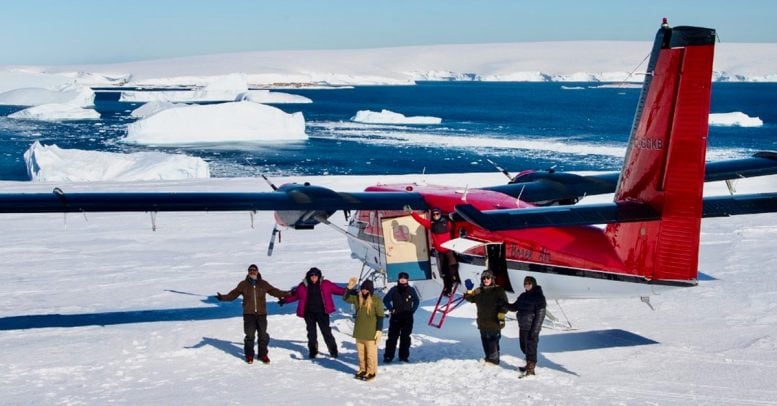
The ANET-POLENET team flew to remote field sites on Antarctica’s Backer Islands to record bedrock uplift. Ohio State University co-author Terry Wilson is second from the left. Credit: Nicolas Bayou
A McGill-led study finds that understanding the relationship between the Antarctic Ice Sheet and the underlying earth is crucial for predicting the impacts of future climate change.
A study led by McGill University indicates that Earth’s natural processes may significantly mitigate Antarctica’s contribution to rising sea levels, provided that carbon emissions are rapidly curtailed in the near future. Conversely, if emissions persist at the current rate, the loss of Antarctic ice could result in a greater increase in sea levels than previously anticipated.
The finding is significant because the Antarctic Ice Sheet is the largest ice mass on Earth, and the biggest uncertainty in predicting future sea levels is how this ice will respond to climate change.
“With nearly 700 million people living in coastal areas and the potential cost of sea-level rise reaching trillions of dollars by the end of the century, understanding the domino effect of Antarctic ice melt is crucial,” said lead author Natalya Gomez, an Associate Professor in McGill’s Department of Earth and Planetary Sciences and Canada Research Chair in Ice sheet – Sea level interactions.

The field team used specialized instruments from the ANET-POLENET project that measure Antarctica’s ground motion. This GNSS [GPS] station is located on an island of the Backer Islands chain in Pine Island Bay where the massive Pine Island Glacier enters the Amundsen Sea. Credit: Terry Wilson
“Our findings show that while some sea level rise is inevitable, swift and substantive action to lower emissions could prevent some of the most destructive impacts of climate change, particularly for coastal communities,” Gomez said.
Rising seas and nature’s double-edged sword
As ice melts, its weight decreases, causing the land beneath it to rise like an expanding sponge. The researchers say this process, called post-glacial uplift, can be a double-edged sword.
If emissions drop quickly, limiting global warming, post-glacial uplift can act as a natural brake on ice-mass loss. It lifts the ice up, slowing the flow of ice from land to ocean. The study found this dynamic can reduce Antarctica’s contribution to sea-level rise by up to 40 percent.
However, if carbon outputs keep pace and the planet heats up quickly, the rebounding land will not be enough to slow the rapidly melting ice, and instead push more ocean water away from Antarctica, accelerating sea-level rise along populated coastlines.
To reach their findings, Gomez and collaborating scholars from Canada and the United States developed a 3-D model of Earth’s interior. Their model used geophysical field measurements from the U.S. ANET-POLENET project, which pioneered large-scale deployments of sensitive instruments to record the bedrock uplift and seismic signals across large expanses of Antarctica. These extensive field measurements were essential for characterizing the three-dimensional variations of the Antarctic mantle incorporated in the study.
“Our 3-D model peels back Earth’s layers like an onion, revealing dramatic variations in thickness and consistency of the mantle below. This knowledge helps us better predict how different areas will respond to melting,” said co-author Maryam Yousefi, a geodesist at Natural Resources Canada and previously a Postdoctoral Fellow at McGill and Penn State universities.
It’s the first model to capture the relationship between Antarctica’s ice and underlying earth in such detail, she added.
Notes Rob DeConto, a co-author and glaciologist at the University of Massachusetts, “This study marks a breakthrough in our ability to better predict the impacts of climate change on rising seas and to inform effective environmental policy.”
Global impacts
The findings, published in Science Advances, highlight the inequalities of climate change, the scholars noted. Island nations, which contribute the least to global emissions, are likely to bear the brunt of their consequences, they said.
Reference: “The influence of realistic 3D mantle viscosity on Antarctica’s contribution to future global sea levels” by Natalya Gomez, Maryam Yousefi, David Pollard, Robert M. DeConto, Shaina Sadai, Andrew Lloyd, Andrew Nyblade, Douglas A. Wiens, Richard C. Aster and Terry Wilson, 2 August 2024, Science Advances.
DOI: 10.1126/sciadv.adn1470
The study is a collaboration between researchers at McGill, Pennsylvania State, Cambridge, Columbia, Colorado State, Ohio State, the University of Massachusetts Amherst, the University of Washington, and the Union of Concerned Scientists. It was funded by the Canadian Natural Sciences and Engineering Research Council, the U.S. National Science Foundation, and the Canada Research Chairs program.









Models of this type are notoriously difficult to validate. The major problem is that one has to wait decades, if not centuries, to compare predictions with results. Good models are difficult to write both because the assumptions about how things work are often wrong and the available data used to derive mathematical functions are often poorly sampled. Note that the authors can’t be sure what basic ice physics model is most appropriate, so they do the calculations for 6 different models.
Notably, when ice depresses the crust, there is invariably what is called a “fore-bulge” where the crust goes up instead of down. When isostatic adjustment takes place, the opposite takes place, expanding the volume of the ocean basin, thus partially compensating for the increased volume of water. I see no reference in the article for that being taken into account.
Also, what I don’t see mentioned is how the Lapse Rate, which controls the rate at which the air cools with elevation, being explicitly taken into account. The ice has to get above zero degrees Celsius for it to melt. I’m left with the impression that they are just looking at the average global temperature rise around the world and assuming that melting will be proportional to that change. However, the high interior is VERY cold, recently reaching -80 degrees C. We are experiencing an average increase of 1-2 degrees C per century, not all of which is under the control of Man. It will be as much as 50 to 80 centuries before Winter temperatures reach the melting point of ice, at current rates, assuming that we don’t enter another Ice Age by then.
Lastly, the potentially most serious projection for sea level rise is associated with the RCP8.5 emissions scenario, whose probability has been called into question because there does not appear to be sufficient fossil fuel resources to support ‘Business as usual’ for the time period being modeled.
Models have their greatest utility in helping understand how dynamic systems work. However, it is ill-advised to take the results too literally. Even the authors note in their paper, “Uncertainty in the AIS’s contribution to future global sea-level projections remains SUBSTANTIAL, with recent estimates ranging from minimal change to tens of meters of change on multi-century timescales.”
Stick around for a few hundred years and you may actually discover how accurate the projections are.